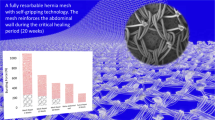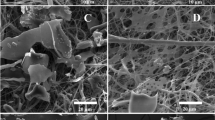Abstract
Purpose
Incisional hernia is the most common complication following abdominal surgery. While mesh repair is common, none of the current meshes mimic the physiology of the abdominal wall. This study compares suture only repair with polypropylene mesh and a prototype of a novel implant (poly-epsilon-caprolactone nanofibers) and their influence on the physiology of an abdominal wall in an animal model.
Methods
27 Chinchilla rabbits were divided into six groups based on the type of the implant. Midline abdominal incision was repaired using one of the compared materials with suture alone serving as the control. 6 weeks post-surgery animals were killed and their explanted abdominal wall subjected to biomechanical testing.
Results
Both—hysteresis and maximum strength curves showed high elasticity and strength in groups where the novel implant was used. Polypropylene mesh proved as stiff and fragile compared to other groups.
Conclusion
Poly-epsilon-caprolactone nanofiber scaffold is able to improve the dynamic properties of healing fascia with no loss of maximum tensile strength when compared to polypropylene mesh in an animal model.


Similar content being viewed by others
References
Meijer EJ, Timmermans L et al. The principles of abdominal wound closure. Acta Chir Belg. 2013;113(4):239–44.
Luijendijk RW, Hop WC et al (2000) A comparison of suture repair with mesh repair for incisional hernia. N Engl J Med 343(6):392–398
Muysoms FE, Antoniou SA et al (2015) European Hernia Society guidelines on the closure of abdominal wall incisions. Hernia 19(1):1–24
Azimi B, Nourpanah P et al (2014) Poly (ε-caprolactone) fiber: an overview. J Eng Fibers Fabr 9(3):74–90
Weyhe D, Belyaev O et al (2007) Improving outcomes in hernia repair by the use of light meshes—a comparison of different implant constructions based on a critical appraisal of the literature. World J Surg 31:234–244
Bringman S, Conze J et al (2010) Hernia repair: the search for ideal meshes. Hernia 14:81–87
Venugopal J, Low S et al (2008) Interaction of cells and nanofiber scaffolds in tissue engineering. J Biomed Mater Res B Appl Biomater 84:34–48
Rampichova M, Chvojka J et al (2012) Elastic three-dimensional poly (ε-caprolactone) nanofibre scaffold enhances migration, proliferation and osteogenic differentiation of mesenchymal stem cells. Cell Prolif 46:23–37
Velayudhan S, Martin D et al (2009) Evaluation of dynamic creep properties of surgical mesh prostheses—uniaxial fatigue. J Biomed Mater Res B Appl Biomater 5:287–296
El Fray M, Prowans P et al (2006) Biocompatibility and fatigue properties of polystyrene-polyisobutylene–polystyrene, an emerging thermoplastic elastomeric biomaterial. Biomacromolecules 7:844–850
El Fray M, Altstadt V. Fatigue behaviour of multiblock thermoplastic elastomers. II. Dynamic creep of poly(aliphatic/aromatic-ester) copolymers. Polymer 2003;44:4643–50.
Lukas D, Sarkar A et al (2009) Physical principles of electrospinning (electrospinning as a nano-scale technology of the twenty-first century). Textile Progress 41:1–83
Klinge U, Conze J et al (1996) Pathophysiology of the abdominal wall. Chirurg 67(3):229–233
Eliason BJ, Frisella MM et al. Effect of repetitive loading on the mechanical properties of synthetic hernia repair materials. J Am Coll Surg. 2011;213(3):430–35.
Bhardway N, Kundu SC (2010) Electrospinning: a fascinating fiber fabrication technique. Biotechnol Adv 28:325–347
Place ES, George JH et al (2009) Synthetic polymer scaffolds for tissue engineering. Chem Soc Rev 38:1139–1151
Li WJ, Danielson KG et al (2003) Biological response of chondrocytes cultured in three-dimensional nanofibrous poly(e-caprolactone) scaffolds. J Biomed Mater Res A. 67:1105–1114
Li WJ, Jiang YJ, Tuan RS (2006) Chondrocyte phenotype in engineered fibrous matrix is regulated by fiber size. Tissue Eng. 12:1775–1785
Ma Z, Kotaki M et al (2005) Potential of nanofiber matrix as tissue-engineering scaffolds. Tissue Eng 11:101–109
Agarwal S, Wendorff JH et al (2008) Use of electrospinning technique for biomedical applications. Polymer 49:5603–5621
Plencner M, East B et al. Abdominal closure reinforcement by using polypropylene mesh functionalized with poly-ε-caprolactone nanofibers and growth factors for prevention of incisional hernia formation. Int J Nanomed. 2014;9:3263–77
Chen M, Patra PK et al (2007) Role of fiber diameter in adhesion and proliferation of NIH 3T3 fibroblast on electrospun polycaprolactone scaffolds. Tissue Eng 13:579–587
Sanders JE, Stiles CE et al (2000) Tissue response to single-polymer fibers of varying diameters: evaluation of fibrous encapsulation and macrophage density. J Biomed Mater Res 52:231–237
Marimuthu M, Kim S (2009) Survey of the state of the art in biomaterials, cells, genes and proteins integrated into micro- and nanoscaffolds for tissue regeneration. Curr Nanosci. 5:189–203
Burger JWA, Luijendijk RW et al (2004) Long-term follow-up of a randomized controlled trial of suture versus mesh repair of incisional hernia. Ann Surg 240(4):578–585
Acknowledgements
The article was supported by the Internal Grant Agency of the Ministry of Health of the Czech Republic (Project no. NV17-32285A).
Author information
Authors and Affiliations
Corresponding author
Ethics declarations
Conflict of interest
All authors state that they have no conflicts of interests that could potentially influence or bias the submitted work.
Ethical approval
The Ethical Principles and Guidelines for Scientific Experiments on Animals were respected throughout this study. The maintenance and handling of experimental animals followed EU Council Directive (86/609 EEC), and the animals were treated in accordance with the principles of Care and Use of Animals. The investigation was approved by the Expert Committee of the Institute of Physiology, Academy of Sciences, Prague, CR, and conformed to Czech Animal Protection Law no. 246/92.
Informed consent
No informed consent.
Additional information
Publisher's Note
Springer Nature remains neutral with regard to jurisdictional claims in published maps and institutional affiliations.
Rights and permissions
About this article
Cite this article
East, B., Plencner, M., Otahal, M. et al. Dynamic creep properties of a novel nanofiber hernia mesh in abdominal wall repair. Hernia 23, 1009–1015 (2019). https://doi.org/10.1007/s10029-019-01940-w
Received:
Accepted:
Published:
Issue Date:
DOI: https://doi.org/10.1007/s10029-019-01940-w




